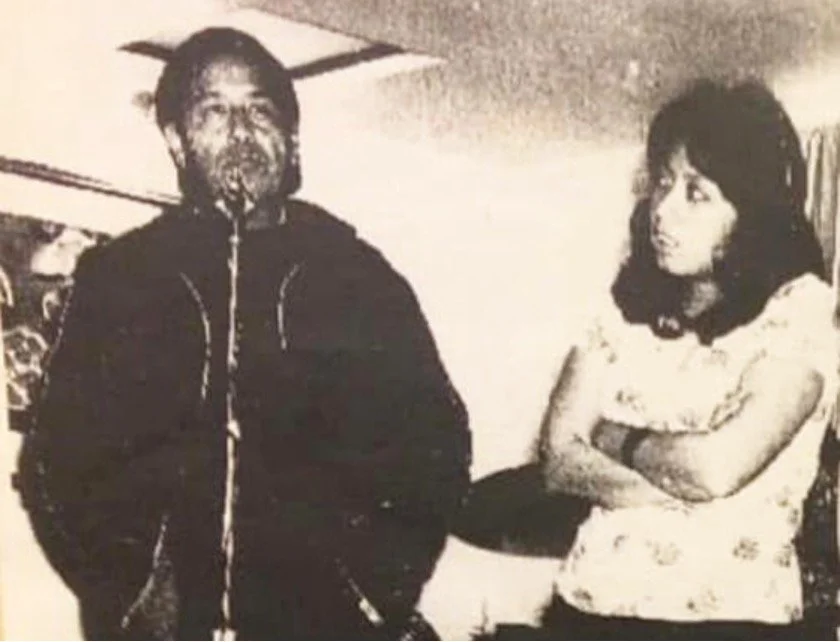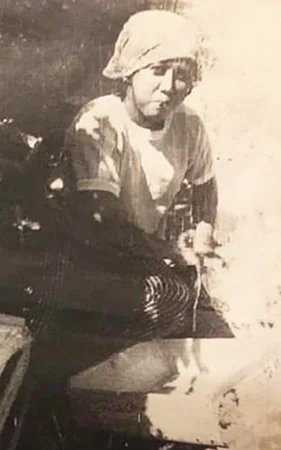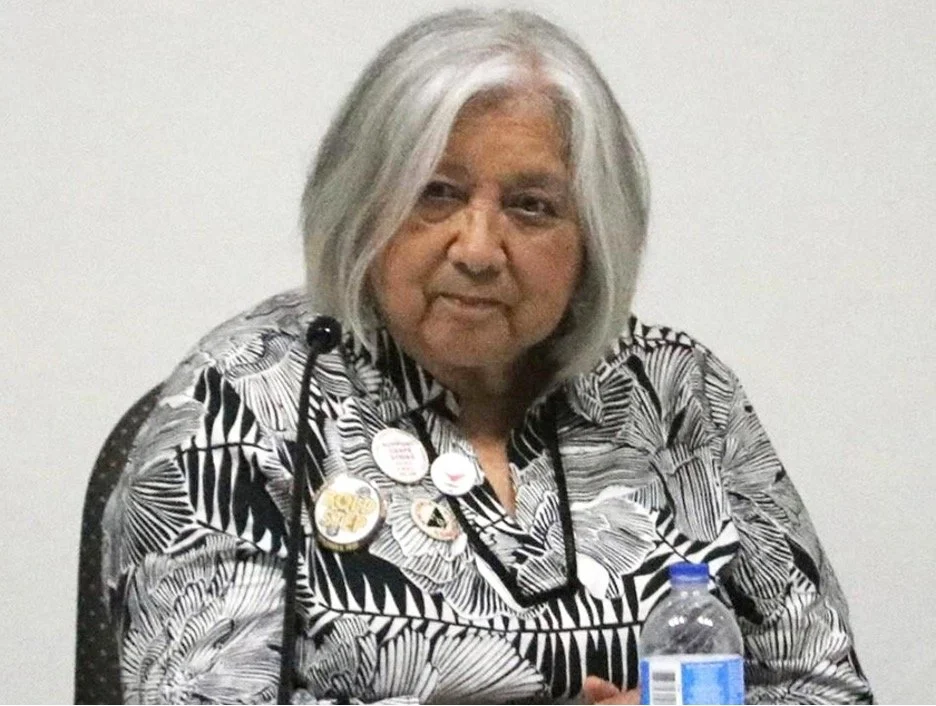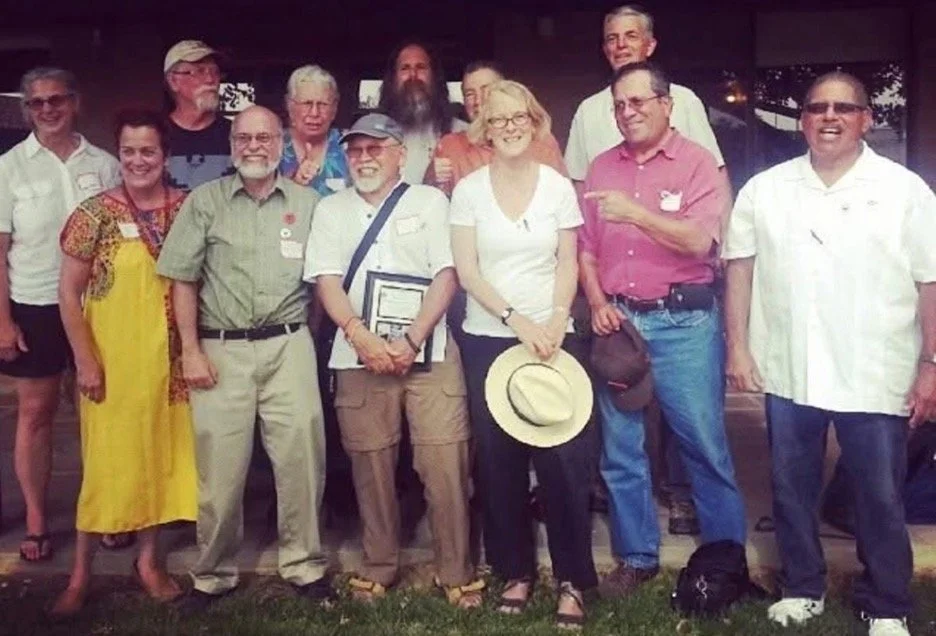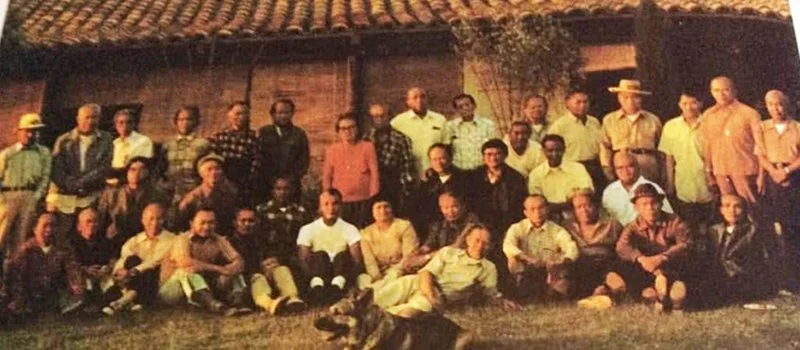Life in the Grape Vineyards of Delano and Beyond
/Cesar Chavez gives a talk in one of the community meetings at Agbayani Village when Lorraine Agtang was manager. (Photo courtesy of Lorraine Agtang)
Lorraine Agtang was only 14. She recalled: “I remember as a kid working in the grape vineyards, tying vines throughout the growing season because kids were allowed to work in the fields.”
Born in a labor camp in Delano to an Ilocano father from Pangasinan and a Mexican mother, Agtang grew up on the east side of the town together with the whites who went to the St. Mary’s Catholic Church. The Mexican and Filipino families lived on the west side of Delano and bumped at each other at the Guadalupe church, a small and simple church with stained glass windows.
The young Lorraine Agtang packing grapes. (Photo courtesy of Lorraine Agtang)
As a child, she was called Lorena instead of Lorenza, the name given to her at birth which was also her mother’s name. But when she started school, her parents named her Lorraine to make it sound more American, as her brother Guillermo whose name was changed into William and another brother Zacarias into Frank.
Just like the rest of the Filipino families of their generation, they had to blend in, assimilate, speak English and were not taught Tagalog, although Agtang said she could pick up some words. And besides, she and her siblings grew up hanging out with the white kids in the neighborhood.
On the morning the strike began, Agtang was working in the vineyard when she heard people shouting the Tagalog word for strike — “welga.” They were urging others to leave the vineyards. “I remember some of the manongs leaving the field and seeing them on the street,” Agtang recalled. She even asked herself at the time, “What’s going on?”
When she saw the manongs, Agtang thought it was odd to see them stop working in the middle of the day. “I know they, we work all the time and working is very important for the manongs because they supported their families in the Philippines,” she added.
“That was my first exposure to civil disobedience and it was kind of awkward,” Agtang declared. “It was a learning experience.”
The Agricultural Workers Organizing Committee led by Larry Itliong, believed they were ready to launch a strike in Delano after a successful strike in the Coachella Valley. Agtang said that Filipinos traveled for work on the farms in the different parts of California, and in the spring of 1965 in Coachella, they waged a strike and got the 10 cents per hour raise they demanded.
“In a few days, the growers paid, no contract, no union, and the Filipinos, who were the main workers got what they wanted,” she added. The growers had no choice but to give in because the weather in Coachella was so hot there was just a short window to pick the grapes.
When Filipino farm workers came to Delano, they wanted to do the same thing, except that Delano is a big community.
AWOC leaders and community leaders gathered with Filipino grape farmworkers on September 8, 1965 at the Filipino Community Hall in Delano and voted to go on strike against the Delano table grape growers. Led by AWOC leaders Itliong, Philip Vera Cruz, Benjamin Gines, and Pete Velasco, the 1,500 strikers demanded pay equal to the federal minimum wage of $1.25 an hour.
Agtang said that Itliong knew that if the Mexicans would not join, they would have a hard time because “they knew they couldn’t win the strike by themselves.” Back in the day, the Mexican and Filipino workers on the farms were separated. “The growers pitted the workers against each other to keep them separated,” she said.
Filipino farm workers challenged the Guimarra Farms, a prominent and major grower in Delano, which had hired Mexicans to cross the picket line. Cesar Chavez said earlier they were not ready because they were not organizing house by house. It was not until the Mexicans were pitted against the Filipinos that the National Farmworkers Association made the decision.
The Mexicans joined the strike eight days later. According to labor leader Dolores Huerta, they had gathered the Mexican farmworkers at the Guadalupe Church and took a vote to support the Filipino manongs. At the time, the growers closed the roads and shut off water in response to the strike.
Although Agtang worked in the fields, she was not very involved in the strike. As kids, they used to hang around the Filipino community hall in Delano where the manongs gathered for food and meetings. “It was interesting for me to see people organizing,” she added.
Both Itliong and Chavez groomed workers to work together. Agtang recalled that even the Filipino and Mexican women cooked food for everyone. “They made sure that both groups signed on the table to build unity, long term unity,” she related pointing out that “since they had that unity in the beginning, they succeeded.”
Lorraine Agtang (right) Polly Parks (left) and Esther Uranday during the funeral march for Cesar Chavez in April 30, 1993. (Photo from Polly Parks Facebook page)
Although the grape strike and boycott lasted five years, the Filipino and Mexican farmworkers — who eventually formed the United Farm Workers — succeeded and won concessions that continue to benefit every worker in the agricultural sector to this day.
UFW’s fiercest opponent, the Guimarra Farms, eventually gave in together with the 25 other grape growers and signed labor contracts that ended the strike and boycott on July 29, 1970. “It was a big thing for them to make a contract with growers,” Agtang said.
As a result of the grape strike and boycott, California passed the Agricultural Labor Relations Act (ALRA) in 1975, which recognized unions and required fairer working conditions. The ALRA granted the farm workers the right to organize and forge collective bargaining agreements with their employers.
That success changed the equation. “If you look now, the Assembly room looks different, representatives do not look white anymore because the union changed the face of our representatives,” Agtang said.
“From then on, ordinary people ran for mayors, school boards, the assembly and that made California different from the rest of the United States,” said Agtang as she recalled the racism growing up in Delano. “Once the strike happened, the white people moved out of Delano. They hated the fact that there was a union of farmworkers.”
Lorraine Agtang in the panel discussion during the 60th anniversary of the grape strike last September 6 in Delano. (Photo by Arnold Morrison)
By February 1974, Agtang was working at Forty Acres, the first headquarters of the United Farm Workers union. After acquiring the site in 1966, Forty Acres gradually expanded its facilities, providing farmworkers access to administrative offices, a cooperative gas station, service and utility areas, a hall, and a boycott organizing space. The complex was built through volunteer labor and has since been designated a National Historic Landmark managed by the National Park Service.
After the strike, the growers closed all the labor camps, and Delano didn’t have homes for single men. The idea of building a village for the manongs began. Temporarily, the manongs lived at the Schenley camp, the labor camp that the union rented during the transition period. The Schenley vineyards signed the first collective bargaining agreement with the farmworkers a year after the strike.
The volunteers who helped build Agbayani Village reunited in 2013. (Photo courtesy of Lorraine Agtang)
With initial funds from the group of Martin Luther King Jr., the main crew as well as volunteers began the construction of Agbayani Village. The construction crew also stayed at the Schenley camp until the completion of the housing project for the manongs.
The retirement village, named in honor of Paolo Agbayani, a Filipino union member who died of a heart attack while on a picket line in 1967, accommodated the elderly and single Filipino farm workers who came to the US in the 1920s and stayed through the 1960s with no place to go.
Union leader Ben Maddock, who had been working with UFW at Forty Acres, asked Agtang if she could manage Agbayani Village on behalf of the union. “I knew the manongs and I loved working with them,” she said as she accepted the responsibility even though she was young.
This photo of Manongs in front of Agbayani Village was published by Harvard Review. (Photo courtesy of Lorraine Agtang)
Agtang, at 22, was the first manager of Agbayani village, a 64-unit apartment complex that the union provided for the manongs, the so-called “lost generation,” so they could live their life in dignity.
“I didn’t tell the manongs how to live their lives, I let them decide the rules,” Agtang narrated, relishing the fondness she had for them and the visits from the outside community, ordinary people and college students who came on weekends to hear their stories.
Many came at least once or three times a year, she said, adding that they have become adopted nephews and nieces and the manongs knew them by name. Everyone just wanted the manongs to know that they were loved,” Agtang further said.
Ben Abad, the last manong who lived at Agbayani Village, died in 1997. The manager of Agbayani Village is Shiela Nadal, Agtang’s niece, and the apartments are still used as housing for people who work in the surrounding communities.
All the photos of the manongs and paintings remain on the walls to remind everyone, especially touring college students, of the rich history of the Agbayani village and its former occupants.
When she left Agbayani village, Agtang did organizing work among Filipinos. It was after the California Legislature passed the Agricultural Labor Relations Act in 1975 which gave farm workers the right to organize, bargain collectively, and improve their working conditions.
“My best efforts socializing and learning to work in the community I learned from the manongs, also to be brave and to take responsibility,” she said proudly.
Agtang settled in Sacramento where she worked for the county for 30 years after she left Delano in 1979. The skills she learned working with manongs were handy and paved the way for her to do well in her second career. Agtang is at peace after managing a program for disadvantaged youth for Sacramento country where she was an employment and training officer and career counselor.
She retired from government service in 2009 yet remains active to this day. There is pride when she talks about watching and taking care of her three grandkids for 18 years–the oldest one is graduating from high school.
She is busy as secretary of the Filipino American National Historical Society of Sacramento, which organizes “talk stories” on the history of Filipinos. As a Catholic, Agtang teaches the faith in the Order of Christian Initiation of Adults.
The fire is still in her. The sense of community, likewise. She loves gardening. Agtang was harvesting figs from the tree when she had to stop to tell us her story, of how it was when she, together with manongs and kapwa, toiled the farms in California, fought for better working conditions, and won the fight. It is a story that deserves to be told and retold.
Reposted with the author’s permission from Philippine Post, September 27, 2025: https://philpostblog.wordpress.com/2025/09/27/life-at-and-beyond-the-grape-vineyards-of-delano/?fbclid=IwdGRzaANHnyRjbGNrA0efCmV4dG4DYWVtAjExAAEeiTFlLWEgWPo8v8llkbM3RzjfXk35BZtQX-CgPAsHVI6rFLABJJY41A7uw5k_aem_XtLRsQcEp1Yo65x89excKA&sfnsn=mo


